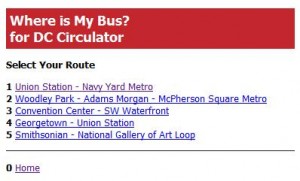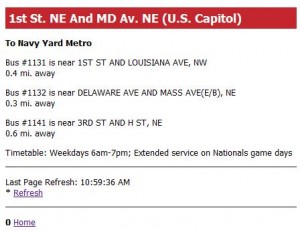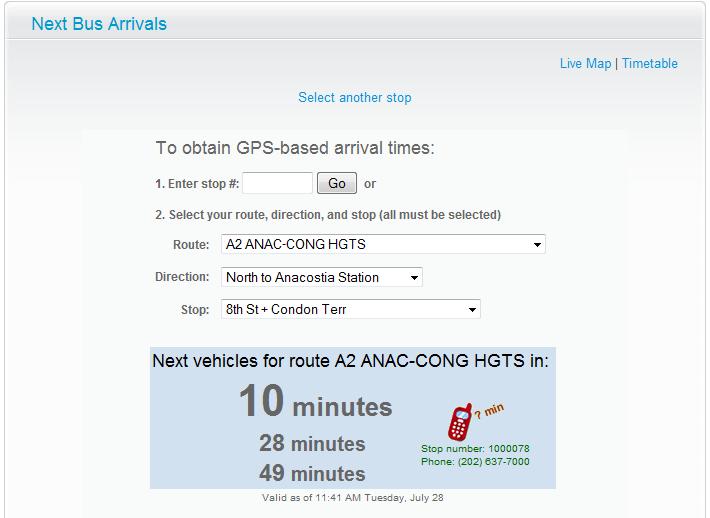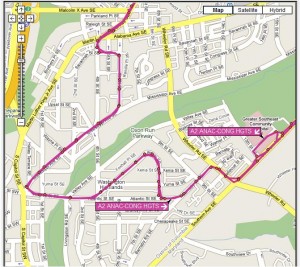GPS tracking devices have been installed in many commercial and government vehicles for several years now, but it hasn’t been until recently that companies and governments are beginning to make this information know at a much broader level. They are sharing the information with the people, empowering them to make informed decision about how they want to make us of public and private services. Most recently, D.C. has seen the debut of 2 bus GPS tracking systems that offer bus riders information about the whereabouts of city buses gathered through GPS.
If you live in the DC area you have probably heard some of the chatter going on about how this GPS tracking stuff is making its way into the hands of regular citizens. In early July, 2009 the D.C. government launched Where’s My Bus – a website accessible from the Internet and certain mobile phones – that will show a user the distance the next bus is from the stop of their choice on the downtown Circulator system. This system was developed using open source software in an effort to save money and to give citizens a voice in the programs development.
Then, just a few weeks later, the Washington Metropolitan Area Transit Authority (WMATA) launched its own bus awareness webpage that utilizes GPS tracking and an algorithm that calculates arrival times for buses in that system. This GPS tracking software, called NextBus because of the proprietary information and process that runs the system, provides a much more robust user experience but ended up costing taxpayers a hefty $3 million.
Having two different GPS bus tracking systems unveiled in such a short amount of time really affords those interested in this type of technology a real opportunity to learn something about the different methods of development and what you can expect from governments in the future. With the Circulator system you have a home-grown, open source software that can be further developed on in later years. With the NextBus system you have the WMATA buying the software package from another company who owns the rights to the software and the traffic algorithm – development and improvement of the system will happen on their terms. Which method is better? Which method provides better results? Let’s take a look and see.
Circulator Where’s My Bus?
 Where’s My Bus? boasts a super simple and straight forward user interface that appears to track two or three dozen different buses. As you can see from a screen shot of the actual landing page at http://circulator.dc.gov/ it is not going to be winning any design awards anytime soon. But what this simple interface allows is compatibility on both mobile phones and smartphones as well as being compatible with Internet browsers.
Where’s My Bus? boasts a super simple and straight forward user interface that appears to track two or three dozen different buses. As you can see from a screen shot of the actual landing page at http://circulator.dc.gov/ it is not going to be winning any design awards anytime soon. But what this simple interface allows is compatibility on both mobile phones and smartphones as well as being compatible with Internet browsers.
From a development perspective this saves a lot of time and effort. It can be a real pain to build a rich interface for a computer bases browser and then have to create a simpler version of the exact same information for mobile phones. The fact that this is what the developers were doing is made clear by a quick look at the html code of http://circulator.dc.gov/ – nothing but simple html written in DTD XHTML Mobile 1.2.
 Where is My Bus? is also very simple in how it communicates the next arrival of a bus, as illustrated by the screen shot to the left. You are given the bus number (which I am sure no user actually knows) along with the route that the bus is on. Then you are given how far away that bus is from that specific stop.
Where is My Bus? is also very simple in how it communicates the next arrival of a bus, as illustrated by the screen shot to the left. You are given the bus number (which I am sure no user actually knows) along with the route that the bus is on. Then you are given how far away that bus is from that specific stop.
This tracking system is very simple, but it gets the job done. Sure, there are a few things that the developers could have done to make it much cooler, but they were trying to make both a webpage for desktops and a webpage for mobile phones. This is hard to do since one uses a 17 inch monitor while the other uses a 3.5 inch display.
My List of Future Improvements:
- Integrate with GoogleMaps’ travel time engine to get rough estimates as to when buses will arrive at stops. While this is anything but fool proof, mixing the distance information made available by the GPS tracking technology on the bus with however Google calucates travel time should be better than nothing, right?
- Get a map on the page already. This can be done by integrating with GoogleMaps or some other similar mapping application. Why this hasn’t already been done is beyond me, but probably has something to do with time and money. This is the obvious next step to making this system that much better.
WMATA NextBus
The WMATA NextBus is simply amazing when compared to Where is My Bus? in terms of features. Just take a look at the eye candy:

But in addition to the eye candy you have a full featured GPS bus tracking system. For example, if you want to know when the next bus is going to arrive a certain stop all you need to do enter the number in box #1. Or, if you don’t really know your stop number but you know your route, the direction you are traveling, and the stop you want to catch the bus at you just enter this information and you will get the next three estimated arrival times (as seen in the darker blue box). Not the distances the bus is from the stop, but a real estimated time until the bus will reach that stop. This is very useful information.
You will also notice that there is a little phone icon in this dark blue box. This has a phone number to call in addition to the route and stop number code for your convenience. How this works is that if you dial the number listed and then enter the route and stop code provided you will with the estimated arrival times. This is great for people who have a little ways to walk before reaching their bus stop or who will be without computer access for a while but still want to use the bus to get home.
 Another great feature available on the NextBus GPS tracking bus route system is that it also offer a GoogleMap-like interface for you to see where buses are on a route and when they might be. It also lets user click on a stop and get the next three estimated arrival times for buses on that route. This is a very cool feature for users.
Another great feature available on the NextBus GPS tracking bus route system is that it also offer a GoogleMap-like interface for you to see where buses are on a route and when they might be. It also lets user click on a stop and get the next three estimated arrival times for buses on that route. This is a very cool feature for users.
I’m not very sure that there are any things that should be added to or improved upon this bus GPS tracking software, but I don’t know how accurate the time predictions are or how usable the system is on a cellular phone. If this works just as well on a mobile phone as it does on a computer then this system is really neat.
Usability and Which Tracking System Has It
Which one would you rather use? I know for certain that the NextBus system is more useful than the Where is My Bus? system. Both are GPS tracking software packages that that give bus riders direct access to this GPS information gathered by these buses, but they do so in very different styles. The style I like the best is definitely NextBus. Its maps and time estimates make it much more user friendly and actually caters to how people think about catching the bus.
I mean no one is going to be able to instantly look at a bus being .4 miles away and go, “Okay, the bus is .4 miles away. A bus traveling on a city street goes about .1 mile every 2 minutes at optimal driving conditions. But today there is a little bit of traffic that I estimate will make it 20% slower. I should get to the bus stop no later than 9 minutes from now just to play it safe.” That is way too much math in public.
While the Where is My Bus? system is a good starting point for development, it is not even in the same league as the NextBus system in terms of usability.
But as a city administrator I would much rather go with the open source version that was cheaper to develop but offers less functionality. Chris Willey, Washington’s interim CTO, put it this way, “We built it intentionally open so somebody else could make it better. If you want to find out when is the next bus, we left it open for the community to figure that out. It’s really about creating a community of developers who are creating applications for government.” While this may not give certain people warm fuzzies all over it is sound thinking and wise decision making.
Knowing that a bus is .4 miles away is still useful information – it is just not as useful as know that it will be getting to the stop in about 8 minutes.
Final Analysis<
In the end, I am glad that government entities and private companies are taking up the call to provide useful GPS tracking systems for the common good. Buses, trains, and trolleys can all benefit from the use of GPS devices. It is just a shame that the cost to do so is $3 million (the cost of the NextBus GPS bus tracking system). There needs to be a cheaper, open source solution if governments are going to be able to implement this functionality for all citizens on all lines of public transportation. That is why the Where is My Bus? tracking system is so interesting – it holds out the hope for a free GPS tracking system for municipalities and states all across the nation and the world.
